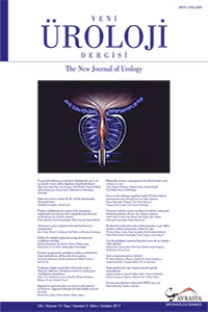Güncel pratikte komplike olmamış idrar yolu enfeksiyonlarında sık karşılaşılan etken mikroorganizmalar ve antibiyotik duyarlılıklarının değerlendirilmesi
Üriner sistem enfeksiyonu, etyolojik ajanlar, antibiyotik duyarlılığı, geleneksel tedavi
The evaluation of the common pathogenic microorganisms in uncomplicated urinary tract infections and the antibiotic susceptibilities in daily practice
Urinary tract infection, ethiologic agents, antibiotic susceptibility, conventional management,
___
- Ronald AR, Pattulo MS. The natural history of urinary in- fection in adults. Med Clin North Am; 75: 299- 312, 1991.
- Gebre-Selassie S. Asymptomatic bacteriuria in pregnancy: epidemiological, clinical and microbiological approach. Ethiop Med J; 36: 185- 92, 1998.
- Liperky BA. Urinary tract infection in men: epidemiology, pathophysiology, diagnosis and treatment. Ann Intern Med; 111:138-50,1989.
- Tambyah PA, Maki DG. Catheter associated urinary tract infection is rarely symptomatic; a prospective study of 1497 catheterized patients. Arch Int Med; 160:678-82,2000.
- Susan A. Mehnert- Kay. Diagnosis and Management of Uncomplicated Urinary Tract Infections. American Family Physician; 72(3): 451- 456,2005.
- Soraya S Andrade, Helio S Sader, Ronald N Jones, Andrea S Pereira, Antônio CC Pignatari, Ana C Gales. Increased re- sistance to first-line agents among bacterial pathogens iso- lated from urinary tract infections in Latin America:time for local guidelines?. Mem Inst Oswaldo Cruz, Rio de Ja- neiro; 101(7): 741- 748,2006.
- Van Nostrand JD, Junkins AD, Bartholdi RK. Poor predic- tive ability of urinalysis and microscopic examination to detect urinary tract infection. Am J Clin Pathol; 113: 709- 13,2000.
- New CH. Urinary tract infection. Am J Med; 4A(suppl): 63- 70,1992.
- Srinivasa H, Parija SC, Bhattacharya S, Sehgal R. Incidence of ciprofloxacin resistance in urinary isolates Eastern Ne- pal. J Comm Dis; 31:45-7,1999.
- Navaneeth BV, Belwadi S, Suganthi N. Urinary pathogens’ resistance to common antibiotics: a retrospective analysis. Trop Doct; 32: 20- 2, 2002.
- Iqbal J, Rahman M, Kabir MS, Rahman M. Increasing cip- rofloxacin resistance among prevalent urinary tract bac- terial isolates in Bangladesh. Jpn J Med Sci Biol; 50: 241- 50,1997.
- Sharafian M, Karimi A, Tabatabaei SR, Anvaripour N. Microbial sensitivity pattern in urinary tractinfections in children:Asingle center experience of 1,177 urine cultures. Jpn.J.Infect.Dis.; 59: 380- 382,2006.
- Abu Shaqra Q. Occurrence and antibiotic sensitivity of Enterobacteriaceae isolated from a group of Jordanian pa- tients with community acquired urinary tract infections. Cytobios; 101: 15- 21,2000.
- Jones RN, Kugler KC, Pfaller MA, Winokur PL. Charac- teristics of pathogens causing urinary tract infections in hospitals in North America: results from the SENTRY An- timicrobial Surveillance Program, 1997. Diagn Microbiol Infect Dis; 35: 55- 63,1999.
- Lomberg H, Hanson LA, Jacobsson B. Correlation of Pblood group,vesicoureteral reflux, and bacterial attach- ment in patients with recurrent pyelonephritis. N Engl J Med; 308: 1189- 92,1983.
- Das R N, Chandrashekhar T S, Joshi H S, Gurung M, Shrestha N, Shivananda P G. Frequency and susceptibility profile of pathogens causing urinary tract infections at a tertiary care hospital in western Nepal Singapore Med J; 47(4) : 281,2006.
- Allen UD, MacDonald N, Fuite L, Chan F, Stephens D. Risk factors for resistance to “first-line” antimicrobials among urinary tract isolates of Escherichia coli in children. CMAJ; 160: 436- 40,1999.
- Hummers-Pradier E, Koch M, Ohse AM, Heizmann WR, Kochen MM: Antibiotic rezistance of urinarypathogens in female general practice patients. Scand J Infect Dis.; 37: 256- 61,2005.
- Farrell DJ, Morrissey I, De Rubeis D, Robbins M, Felm- ingham D: A UK multicentere study of the antimicrobial susceptibility of bactyerial pathogens causing urinary tract infection. J Infect.; 46: 94- 100,2003.
- Kahlmeter G; ECO.SENS. An international survey of the antimicrobial susceptibility of pathogens from uncompli- cated urinary tract infections: the ECO.SENS Project. J An- timicrob Chemother; 51: 69- 76, 2003.
- ISSN: 1305-2489
- Yayın Aralığı: 3
- Başlangıç: 2005
- Yayıncı: Pera Yayıncılık
Makroskopik hematürinin ender bir nedeni: Mesane tümörünü taklit eden şistozomiazis
Mehmet KALKAN, Coşkun ŞAHİN, Ergün UÇMAKLI, Hülya ÇAŞKURLU
Paraüretral leiyomyom: Olgu sunumu
Orhan BAYIR, Mustafa KAYGISIZ, Cemil ÖZTÜRK, Ayşegül Aksoy ALTINBOĞA, Orhan OYAR, Ahmet BÖLÜKBAŞI
Mehmet Bilgehan YÜKSEL, Bülent GÜNLÜSOY, Ali Rıza AYDER
Retrograd intrarenal cerrahi; uygulama tekniği, klinik sonuçlar ve ipuçları
Cabir ALAN, Hasan KOÇOĞLU, Ahmet Reşit ERSAY
Erdal BENLİ, Orhan KOCA, İlhan GEÇİT
Persistan müllerian kanal sendromu, transvers testiküler ektopi ve hipospadias birlikteliği
Kliniğimizdeki mesane tümörlü hastaların geriye dönük analizi
Bülent ALTUNOLUK, Erkan EFE, Tayfun ŞAHİNKANAT, Sefa RESİM, Ali İhsan TAŞÇI
Tüberküloz Epididimoorşit: Olgu Sunumu
Esat Kaan AKBAY, Ülkü KÜÇÜK, Fırat AKDENİZ, Emel Ebru PALA, Gökhan KOÇ, Ümit BAYOL, Yüksel YILMAZ
